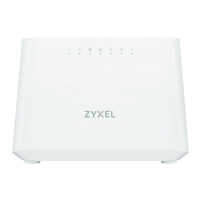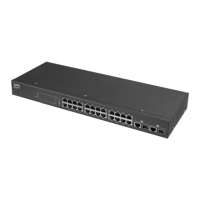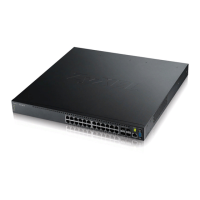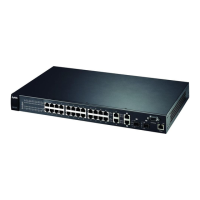Do you have a question about the ZyXEL Communications EX5601-T0 and is the answer not in the manual?
Introduces the Zyxel Device models and their features.
Explains how to create a shared folder on a USB device for access by others.
Describes the front and rear panels for each Zyxel Device model.
Shows the Zyxel Device LED indicators panel and their behaviors.
Shows the Zyxel Device ports panel and connection ports.
Provides step-by-step instructions for installing and removing SFP transceivers.
Explains how to use the WPS button for quick WiFi connection setup.
Describes how to use the RESET button to restore factory default settings.
Introduces the Web Configurator as an HTML-based management interface.
Provides steps to connect to the administrative Web Configurator.
Introduces the Wizard screens for configuring time zone and WiFi settings.
Guides users through the initial setup using the Wizard screens.
Explains how to select the correct time zone for the Zyxel Device.
Describes how the Zyxel Device detects and displays Internet connection status.
Provides troubleshooting steps for detecting a WAN connection issue.
Guides on turning WiFi on/off, recording WiFi Name and Password.
Introduces how to use the Zyxel Device's various features via the web interface.
Shows how to set up DSL or Ethernet Internet connection using Broadband screens.
Guides on setting up a DSL Internet connection using the Web Configurator.
Explains how to connect to the Internet through an Ethernet connection to the WAN port.
Guides on setting up a WiFi network for Internet access using the Zyxel Device as an AP.
Demonstrates changing default security settings to WPA3-SAE/WPA2-PSK for enhanced security.
Explains how to connect a WiFi device using WPS (Wi-Fi Protected Setup).
Details creating two WiFi networks for different user groups with separate SSIDs and security modes.
Shows how to create a shared folder on a USB device for access.
Explains configuring firewall rules, parental control, and MAC filter.
Describes enabling the firewall to protect LAN computers from Internet attacks.
Shows how to configure rules for accessing the Internet using parental control.
Explains using a MAC address filter to allow or deny access on the wired LAN.
Provides steps to add a SIP service provider to the Zyxel Device.
Guides on configuring a SIP account and mapping it to a phone port.
Explains how to configure the phone port to use the SIP account.
Provides steps to make a phone call using Voice over IP (VoIP).
Covers upgrading firmware, backing up, and restoring device configurations.
Introduces using the MPro Mesh app to manage Zyxel Devices and MPro Mesh networks.
Explains MPro Mesh support for WiFi network management using routers and extenders.
Guides on connecting MPro Mesh Router with Extenders via WiFi or wired connection.
Provides steps to set up MPro Mesh Router with an MPro Mesh Extender.
Describes creating an MPro Mesh network with a wired connection to extenders.
Advises changing default WiFi settings for better security and reconnection.
Uses Parental Control to configure schedule profiles limiting client Internet access.
Explains blocking a specific client's Internet access immediately using the Pause Internet function.
Guides on setting up a separate Guest WiFi network for visitors, with its own SSID and password.
Explains the Connection Status screen for Internet and WiFi settings.
Guides on enabling/disabling the main WiFi network, checking SSIDs, and passwords.
Explains enabling/disabling guest WiFi networks and checking SSIDs/passwords.
Allows viewing parental control profiles and enabling parental control.
Guides on adding devices to a profile and blocking Internet access on profile devices.
Discusses Broadband screens for configuring Zyxel Device for Internet access.
Explains changing Zyxel Device Internet access settings for DSL routers.
Guides on configuring a WAN connection, varying by mode, encapsulation, and IP mode.
Explains changing Zyxel Device Internet access settings for Ethernet, AON, and PON routers.
Explains using a USB cellular dongle for wireless Internet access as a backup.
Describes Network Setting > Wireless screens for WiFi setup and security.
Guides on enabling WiFi, entering SSID, and selecting WiFi security mode.
Allows configuration of guest WiFi networks with varying security types and SSIDs.
Explains granting or excluding access based on MAC addresses of connected devices.
Details configuring WiFi Protected Setup (WPS) for quick and secure WiFi connection.
Introduces Local Area Network (LAN) and LAN screens for DHCP server and IP management.
Explains setting LAN IP address, subnet mask, and DHCP settings.
Guides on assigning fixed IP addresses to LAN clients based on MAC addresses.
Explains how the Zyxel Device uses the default gateway and static routes.
Allows viewing and configuring static route rules for saving time and bandwidth.
Guides on adding or editing a static route rule.
Defines QoS and its role in delivering data with minimum delay and controlling bandwidth.
Enables QoS, sets upstream bandwidth, and assigns traffic priority.
Explains NAT as IP address translation for packet routing between networks.
Forwards incoming service requests from the Internet to servers on the local network.
Guides on adding or editing port forwarding rules.
Explains DNS for mapping domain names to IP addresses and vice versa.
Explains firewall functions: protecting against attacks, controlling access.
Allows setting the firewall security level and grouping rules by packet travel direction.
Displays and configures incoming or outgoing filtering rules (ACL rules).
Activates protection against Denial of Service (DoS) attacks.
Explains configuring access based on MAC addresses for wired connections.
Enables MAC Address Filter and adding host name and MAC address for wired LAN clients.
Guides on enabling or disabling filters per entry by selecting Active and specifying Host Name and MAC Address.
Explains limiting user Internet access and preventing access to inappropriate content.
Enables parental control and defines rules/schedules in a Parental Control Profile (PCP).
Guides on adding devices to a profile and blocking Internet access on profile devices.
Enables parental control and allows configuring restricted access schedules and URL filtering.
Introduces making phone calls over the Internet using VoIP technology and SIP accounts.
Explains viewing settings for 'admin' and other user accounts for Zyxel Device management.
Allows creating or managing user accounts and their privileges on the Zyxel Device.
Explains remote management controls for accessing the Zyxel Device via interfaces and web services.
Configures log destination (local file or remote syslog server) and log types.
Explains how to upload new firmware for Zyxel Device from service provider.
Lets users upload new firmware to Zyxel Device via HTTP.
Provides information on factory default settings and backup configuration.
Allows backing up and restoring Zyxel Device configurations or resetting to factory defaults.
Displays information to help identify problems with the Zyxel Device.
Allows ping, traceroute, nslookup, or speed test for troubleshooting.
Offers suggestions to solve potential problems encountered with the Zyxel Device.
Addresses issues like the Zyxel Device not turning on or LEDs not behaving as expected.
Troubleshoots issues related to knowing the IP address, forgetting passwords, or accessing Web Configurator.
Provides troubleshooting steps for accessing the Internet via Fiber, Ethernet, or Cellular connections.
Discusses wireless security methods: data encryption, client authentication, MAC filtering, SSID hiding.
Provides crucial safety instructions for device usage, installation, and handling.
| Product Type | Wireless Router |
|---|---|
| Wi-Fi Standard | Wi-Fi 6 (802.11ax) |
| USB Ports | 1 x USB 3.0 |
| Security Protocols | WPA3 |
| Frequency Band | 2.4 GHz / 5 GHz |











